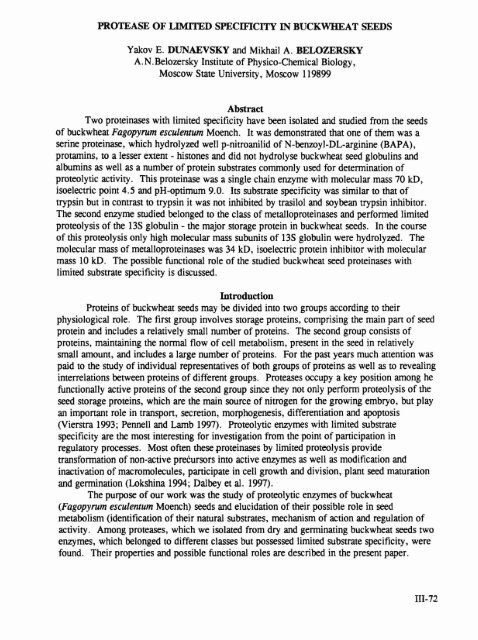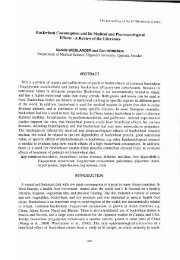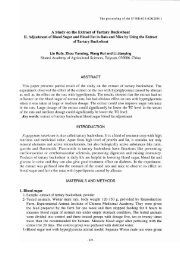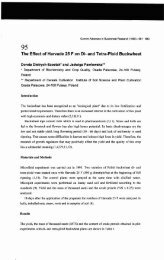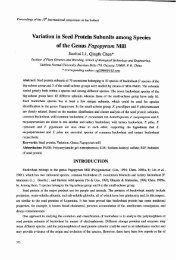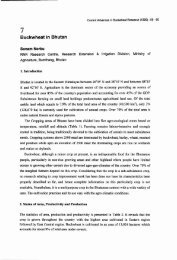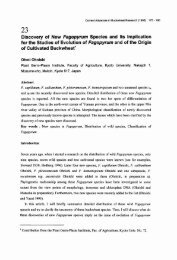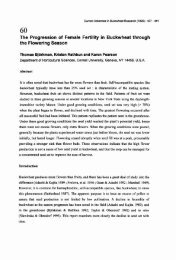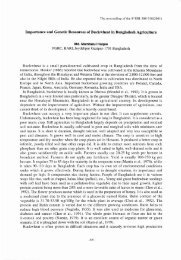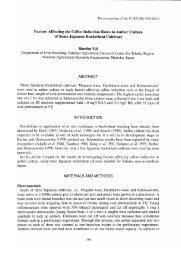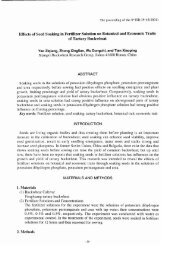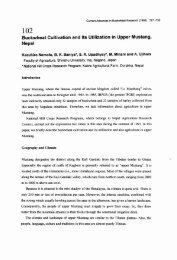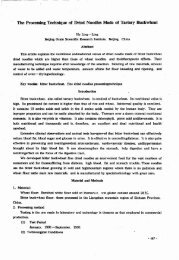Yakov E. Dunaevsky and Mikhail A. Belozersky Protease ofLimited ...
Yakov E. Dunaevsky and Mikhail A. Belozersky Protease ofLimited ...
Yakov E. Dunaevsky and Mikhail A. Belozersky Protease ofLimited ...
Create successful ePaper yourself
Turn your PDF publications into a flip-book with our unique Google optimized e-Paper software.
PROTEASE OF LIMITED SPECrnCITY IN BUCKWHEAT SEEDS<br />
<strong>Yakov</strong> E. DUNAEVSKY<strong>and</strong> <strong>Mikhail</strong> A. BELOZERSKY<br />
A. N. <strong>Belozersky</strong> Institute of Physico-Chemical Biology,<br />
Moscow State University, Moscow 119899<br />
Abstract<br />
Two proteinases with limited specificity have been isolated <strong>and</strong> studied from the seeds<br />
of buckwheat Fagopyrum esculentum Moench. It was demonstrated that one of them was a<br />
serine proteinase, which hydrolyzed well p-nitroanilid of N-benzoyl-DL-arginine (BAPA),<br />
protamins, to a lesser extent - histones <strong>and</strong> did not hydrolyse buckwheat seed globulins <strong>and</strong><br />
albumins as well as a number of protein substrates commonly used for determination of<br />
proteolytic activity. This proteinase was a single chain enzyme with molecular mass 70 kD,<br />
isoelectric point 4.5 <strong>and</strong> pH-optimum 9.0. Its substrate specificity was similar to that of<br />
trypsin but in contrast to trypsin it was not inhibited by trasilol <strong>and</strong> soybean trypsin inhibitor.<br />
The second enzyme studied belonged to the class of metalloproteinases <strong>and</strong> performed limited<br />
proteolysis of the 13S globulin - the major storage protein in buckwheat seeds. In the course<br />
of this proteolysis only high molecular mass subunits of 13S globulin were hydrolyzed. The<br />
molecular mass of metalloproteinases was 34 kD, isoelectric protein inhibitor with molecular<br />
mass 10 kD. The possible functional role of the studied buckwheat seed proteinases with<br />
limited substrate specificity is discussed.<br />
Introduction<br />
Proteins of buckwheat seeds may be divided into two groups according to their<br />
physiological role. The first group involves storage proteins, comprising the main part of seed<br />
protein <strong>and</strong> includes a relatively small number of proteins. The second group consists of<br />
proteins, maintaining the normal flow of cell metabolism, present in the seed in relatively<br />
small amount, <strong>and</strong> includes a large number of proteins. For the past years much attention was<br />
paid to the study of individual representatives of both groups of proteins as well as to revealing<br />
interrelations between proteins of different groups. <strong>Protease</strong>s occupy a key position among he<br />
functionally active proteins of the second group since they not only perform proteolysis of the<br />
seed storage proteins, which are the main source of nitrogen for the growing embryo, but play<br />
an important role in transpon, secretion, morphogenesis, differentiation <strong>and</strong> apoptosis<br />
(Vierstra 1993; Pennell <strong>and</strong> Lamb 1997). Proteolytic enzymes with limited substrate<br />
specificity are the most interesting for investigation from the point of participation in<br />
regulatory processes. Most often these proteinases by limited proteolysis provide<br />
transformation of non-active preCursors into active enzymes as well as modification <strong>and</strong><br />
inactivation of macromolecules, participate in cell growth <strong>and</strong> division, plant seed maturation<br />
<strong>and</strong> germination (Lokshina 1994; Dalbey et al. 1997).<br />
The purpose of our work was the study of proteolytic enzymes of buckwheat<br />
(Fagopyrum esculentum Moench) seeds <strong>and</strong> elucidation of their possible role in seed<br />
metabolism (identification of their natural substrates, mechanism of action <strong>and</strong> regulation of<br />
activity. Among proteases, which we isolated from dry <strong>and</strong> germinating buckwheat seeds two<br />
enzymes, which belonged to different classes but possessed limited substrate specificity, were<br />
found. Their propenies <strong>and</strong> possible functional roles are described in the present paper.<br />
III-72
Materials <strong>and</strong> Methods<br />
Buckwheat Fagopyrum escu[entum seeds cv. Shatilovskaya-5 were used. Purification<br />
of BAPAase, proteinase hydrolyzing BAPA, was carried out by acetone fractionation, ionexchange<br />
chromatography on DEAE-Sephadex A-50, gel-filtration on Sephadex G-150 <strong>and</strong><br />
preparative PAGE (pH 8.3). Metalloproteinase was isolated as described previously<br />
(<strong>Belozersky</strong> et al. 1990), using gel-filtration on Sepharose 6B, ion-exchange chromatography<br />
on DEAE-Toyopearl, gel-filtration on Ultra-gel AcA 54 <strong>and</strong> two FPLC procedures on Mono S<br />
at pH 5.8 <strong>and</strong> 8.15 The metalloproteinase inhibitor was isolated by affinity chromatography<br />
on trypsin-Sepharose 4B <strong>and</strong> ion-exchange chromatography on DEAE-cellulose<br />
(Voskoboynikova et al. 1990).<br />
Proteolytic activity towards BAPA <strong>and</strong> N-benzoyl-DL-Iysine p-nitroanilide (BLPA) was<br />
determined spectrophotometrically at 410 om in 0.1 M phosphate, pH 8.0 at 37°C (Erlanger et<br />
al. 1961). Activity on protein substrates was determined by trinitrophenylation (Habeeb 1966)<br />
in 0.01 M phosphate, pH 8.0 at 37°C after incubation of the enzymes with substrates for 18 h.<br />
Results <strong>and</strong> Discussion<br />
<strong>Protease</strong>, hydrolyzing well synthetic substrate N-benzoyl-DL-arginine-p-nitroanilide<br />
<strong>and</strong> named BAPAase, proved to be the most typical representative of enzymes with limited<br />
specificity. It was purified to homogeneity from dry buckwheat seeds what was evidence by<br />
PAGE analysis in the absence <strong>and</strong> presence of SDS, isoelectric focussing (pH gradient 4-6)<br />
<strong>and</strong> analytical untracentrifugation. Main characteristics of the purified enzyme are presented<br />
in Table 1.<br />
Table 1.<br />
Properties of proteases of limited specificity from buckwheat seeds<br />
Enzyme Source M r (kD) pH-optimum pi S20,w<br />
BAPAase dry seeds 65 (g-f) 9.0 4.5 4.3<br />
70 (PAGE)<br />
Metalloproteinase dry seeds 39 (g-f) 8.2 > 9.6 n.d.<br />
34 (PAGE)<br />
*g-f - gel-filtration<br />
Molecular mass of the BAPAase was 65 kD according to gel-filtration on Sephadex G<br />
100 <strong>and</strong> 70 kD according to SOS-PAGE analysis. These data indicate that buckwheat seed<br />
BAPAase is a single chain enzyme. The isoelectric point of BAPAase was 4.5 <strong>and</strong> its pHoptimum<br />
was in the alkaline region of pH 9.0.<br />
Investigation of the functional groups at the active centre of the enzyme revealed that<br />
BAPAase is a serine proteinase with serine <strong>and</strong> histidine residues at the active centre (Table 2).<br />
111-73
Table 2.<br />
Effect of inhibitors <strong>and</strong> activators on BAPAase <strong>and</strong> metalloproteinase activities<br />
Residual activity (%)<br />
Concentration<br />
Metal10-<br />
Reagent (nM) BAPAase proteinase<br />
DiisopropyIfluorophosphate 0.1 0 100<br />
Tosyl-L-lysinechloromethyl ketone 0.1 0 n.d.<br />
Tosyl-L-phenylalaninechloromethyl ketone 0.1 100 n.d.<br />
p-Chloromercuribenzoate 1.0 148 80<br />
NaCI 170 100 n.d.<br />
N-ethylmaleimide 1.0 72 n.d.<br />
EDTA 3.0 100 0<br />
Trasilol 0.01 98 n.d.<br />
Soybean trypsin inhibitor 0.1% 100 n.d.<br />
1.1O-phenantroline 1.0 n.d. 0<br />
Zincon 1.0 n.d. 0<br />
Pepstatin 0.16 100 100<br />
It was surprising that BAPAase was activated with p-chloromercuribenzoate (to 50%)<br />
<strong>and</strong> this activation was not caused by Cl- ions.<br />
The study of the substrate specificity of the BAPAase showed that this enzyme<br />
hydrolyzed peptide, amide <strong>and</strong> ester bonds, formed by carboxyl groups of arginine <strong>and</strong> lysine<br />
when N- <strong>and</strong> C- terminal groups of amino acid residue in the used substrates were blocked.<br />
BAPAase showed a higher affinity to arginine residues than to lysine. When the same<br />
concentrations of BAPA <strong>and</strong> BLPA were used the initial rate of hydrolysis of the first substrate<br />
was 2.5-fold higher than of the second. Buckwheat seed BAPAase did not hydrolyse albumins<br />
<strong>and</strong> globulins from these seeds as well as a number of other proteins, usually used as<br />
proteinase substrates, weakly hydrolyzeP histones <strong>and</strong> good - protarnins. Analysis of peptide<br />
bonds, cleaved by the enzyme irr the oxidized insulin B-chain, carried out by dansil technique<br />
indicated that only a single bond Arg-Gly was cleaved (Fig. 1).<br />
111-74
BAPAase<br />
5 10 15 20 25 30<br />
F-V-N-Q-H-L-C-G-S-H-L-V-E-A-L-Y-L-V-C-G-E-R-G-F-F-Y-T-P-K-A<br />
I<br />
S03H<br />
Metalloproteinase 1 1<br />
I<br />
S03H<br />
Fig. 1 Cleavage sites of insulin B-chain by buckwheat seed BAPAase <strong>and</strong><br />
metalloproteinase<br />
In its action on synthetic substrates <strong>and</strong> insulin B-chain buckwheat seed BAPAase is<br />
very similar to trypsin. However, in contrast to trypsin it was not inhibited by trasilol (trypsin<br />
inhibitor from calf lungs) <strong>and</strong> soybean trypsin inhibitor (Table 2).<br />
Thus, the obtained data on the effect of buckwheat seed BAPAase on protein substrates<br />
indicate that this enzyme is a proteinase with limited substrate specificity <strong>and</strong>, possibly, may<br />
have its specific substrate. As a possible substrate might serve an arginine-rich protein,<br />
determined histochemically in seeds of several plants (Fulcher et al. 1972). On the other<br />
h<strong>and</strong>, one cannot exclude that BAPAase may carry out limited proteolysis of few (one-two)<br />
key peptide bonds in proteins what is rather difficulty to determine by usual techniques.<br />
Another proteinase with narrow specificity <strong>and</strong> capable of limited proteolysis was also<br />
found in dry buckwheat seeds but belonged to a different class of proteolytic enzymes. It was<br />
purified 1000-fold, obtained homogeneous <strong>and</strong> was completely inhibited only by<br />
metalloenzymes inhibitors such as EDTA <strong>and</strong> 1,10-phenantroline (Table 2). The isolated<br />
enzyme was classified as metalloproteinase according to atomic-absorption spectroscopy which<br />
showed that the studied proteinase contained one Zn 2 + ion per enzyme molecule. Inhibition of<br />
the enzyme with EDTA did not result in removal of the zinc ion from the active centre.<br />
Activity of the enzyme, inactivated with EDTA, was completely restored after addition of<br />
Zn2+, eo2+ or Mg 2 + ions. At the same time treatment of the active enzyme preparation with<br />
additional amount of these cations as well as Ca2+ ions did not activate it more. According to<br />
these data one may suggest that Mg2+, Co2+ <strong>and</strong> Zn 2 + activate inactive metalloproteinase<br />
competing with Zn2+ at the active centre of the enzyme for binding EDTA. The main<br />
characteristics of the studied metalloproteinase are given in Table 1. Its molecular mass was<br />
34 kD according to SDS PAGE-analysis <strong>and</strong> 39 kD according to gel-filtration on Sephadex G<br />
150. These data indicate that metalloproteinase is a single chain enzyme. The pH-optimum of<br />
the enzyme towards buckwheat seed 13S globulin was 8.0-8.2 <strong>and</strong> isoelectric point was higher<br />
9.6.<br />
To study the effect of metalloproteinase on protein substrates typical seed storage<br />
proteins (buckwheat seed 13S globulin, .soybean glycinin) were used as well as exogenous<br />
proteins (BSA, casein, hemoglobin), which are often used as the substrates for determination<br />
of proteolytic activity (Table 3).<br />
111-75
Substrate<br />
BSA<br />
Hemoglobin<br />
Soybean lIS globulin<br />
Buckwheat 13S globulin<br />
Table 3.<br />
Effect of metalloproteinase on protein substrates.<br />
Amino groups released, Bonds hydrolyzed,<br />
nmol.mg- 1 %.mol- 1<br />
10<br />
15<br />
85<br />
135<br />
0.12<br />
0.16<br />
1.00<br />
1.50<br />
Measurement of the amino groups liberated after hydrolysis indicated that<br />
metalloproteinase expressed weak activity towards the used substrates. Calculations showed<br />
that degree of hydrolysis of 13S globulin <strong>and</strong> glycinin was approximately similar. The enzyme<br />
split 30 peptide bonds (1 %) per glycinin molecule <strong>and</strong> 36 bonds (1.5% per 13S globulin<br />
molecule. Detailed analysis of hydrolysis by metalloproteinase of endogenous buckwheat seed<br />
13S globulin revealed that is predominantly cleaved high molecular mass subunits (57.5, 47.6<br />
<strong>and</strong> 44.7 kD) of this protein. Data on the quantitative analysis of 13S globulin hydrolysis <strong>and</strong><br />
the study of electrophoretograms of the hydrolysis products indicate that the studied<br />
metalloproteinase performs limited proteolysis of the storage protein. As it was demonstrated<br />
in our further experiments only the storage protein, modified by metalloproteinase through<br />
limited proteolysis, could be later subjected to profound proteolysis by other less specific<br />
buckwheat seed proteases.<br />
Hydrolysis of the oxidized insulin B-chain, carried out to reveal the peptide bonds<br />
cleaved by metalloproteinase, <strong>and</strong> followed by separation of hydrolysis products by reverse·<br />
phase HPLC <strong>and</strong> their amino acid analysis, indicated that three peptide bonds Ala I4 _Leu 1s ,<br />
Leu lS _Tyr 16 <strong>and</strong> Phe 24·Phe25 (Fig. 1) were split. Comparison of the peptide bonds, hydrolyzed<br />
by metalloproteinase in the oxidized insulin B-chain, with the products of its hydrolysis by<br />
some bacterial <strong>and</strong> animal metalloproteinases showed that the studied buckwheat proteinase<br />
possessed the most narrow substrate specificity. It hydrolyzed mainly only three peptide bonds<br />
whereas other metalloproteinases hydrolyzed from 6 to 14 bonds.<br />
We have found that activity of the investigated metalloproteinase was controlled by<br />
endogenous protein inhibitor. Highly purified inhibitor had molecular mass 10-12 kD <strong>and</strong><br />
isoelectric point 4.8. It was acid <strong>and</strong> thermostable what may be, possibly, due to the tighmess<br />
of its globular structure <strong>and</strong> is a characteristic property of almost all protein protease inhibitors<br />
of plant origin. Complete inactivation of metalloproteinase was observed in its presence<br />
expressed in the loss of ability of the enzyme to cleave high molecular mass subunits of 13S<br />
globulin. The presence of the metalloproteinase inhibitor in dry seeds together with the<br />
narrow specificity of metalloproteinase indicated that proteolysis of the main buckwheat seed<br />
storage protein was a precisely regulated process, playing an important role in the effective<br />
supply of the growing embryo with nitrogen compounds.<br />
Thus, dry buckwheat seeds contain at least two highly specific proteinases, which<br />
belong to different classes ofproteolytic enzymes <strong>and</strong> performing, apparently, different<br />
functions. The existence of enzymes of this kind gives living organisms a possibility to<br />
regulate precisely vitally imponant metabolic processes.<br />
III-76
Acknowledgements<br />
The work was supponed by grants from the Russian Foundation for Basic Research <strong>and</strong><br />
State Program "International Projects".<br />
References<br />
1. <strong>Belozersky</strong> M.A., <strong>Dunaevsky</strong> Y.E., Voskoboynikova N.E. (1990). Biochern. J. 272,<br />
677-682.<br />
2. Dalbey R.E., Lively M.O., Bron S., Van Dijl J.M. (1997). Protein Science 6,1129<br />
1138.<br />
3. Erlanger B.F., Kokowsky N., Cohen W. (1961). Arch. Biochem. Biophys. 95,271<br />
278.<br />
4. Fulcher RG., O'Brien T.P., Simmonds D.H. (1972). Austral. J. BioI. Sci. 25,487<br />
492.<br />
5. Habeeb T.S. (1966). Anal. Biochern. 14, 328-336.<br />
6. Lokshina L.A. (1994). Bioorgan. Chern. 20, 134-142.<br />
7. Pennell R 1., Lamb C. (1997). Plant Cell 9, 1157-1168.<br />
8. Vierstra RD. (1993). Ann. Rev. Plant PhysioI. Plant Mol. BioI. 44, 385-410.<br />
9. Voskoboynikova, N.E., <strong>Dunaevsky</strong> Y.E., <strong>Belozersky</strong> M.A. (1990). Biochemistry 55,<br />
839-847.<br />
III-77


